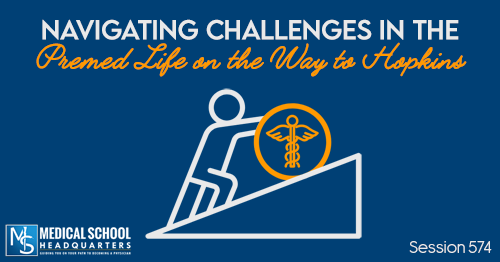Apple Podcasts | Google Podcasts
Session 480
Today, we chat with Karen, an amazing incoming medical student from Brazil who made it into a U.S. medical school. Let’s talk about her path and what it takes for an international student to get into U.S. medical schools.
“There's a lot of bad information out there about what it takes to get into medical school as an international student.”Click To TweetThere is a lot of fear out there that international students have to be perfect students, or else they’ll never get into medical school.
Hopefully, our conversation today with Karen will bust that myth and give you some information and motivation on your journey to medical school if you are an international student.
Get access to free mentorship as an international student and check out F1 Doctors. For more podcast resources to help you with your medical school journey and beyond, check out Meded Media.
Listen to this podcast episode with the player above, or keep reading for the highlights and takeaway points.
[02:22] Interest in Becoming a Physician
Born and raised in Brazil, Karen grew up with a dad who was a physician that greatly influenced her. She explains that in Brazil, you don’t get to choose which classes you take like you’re doing in the United States. They have a preset curriculum for you.
One of the reasons she wanted to get into the health care field was that when Karen was 14 years old, she lost one of her closest friends to suicide.
That made her start questioning things about the healthcare system and how mental health is looked at. At that point, she started to commit more of her time to service. And it was from there having the experiences in the clinic, volunteering, having the patient exposure, and having those meaningful interactions that she realized medicine was the right path for her.
'Medicine is not just a career, it is a calling.'Click To TweetAware of the technological and scientific advancements in the U.S., Karen wanted to come to the United States for that. In 2014, Karen moved to the U.S. in her junior year of high school. She lived in Washington with a host family and fully immersed herself in the culture.
[07:39] Restrictions in a Student Visa
As a premed student, specifically, on a student visa, there are lots of restrictions for what you can and can’t do. That includes the clinical experiences and the things you’re expected to do as a premed.
Karen admits that it’s hard for international students to get in. There are around 140 accredited medical schools in the U.S., and only 30% to 35% of those schools accept international applications.
In the United States, there are less than 1% of international students that matriculated in medical school. Karen wasn’t able to get paid positions outside because that wasn’t part of the visa description.
[11:46] How to Transition from a Student Visa to a Working Visa
Karen still has an F-1 visa, which is the normal student visa. She explains that if you graduate from an undergraduate institution, you can apply for an OPT or optional practical training. This gives you an extra year, where you can still be working on your education. You’re still sponsored by the same institution, but you can be somewhere else.
Then for STEM majors, you can also apply for STEM OPT which gives you an extra two years. Karen is in her second gap year right now.
'You have to rely on your support system and do your research.'Click To TweetKaren feels very fortunate to have found a job during COVID and they took her in as an immigrant, and it all worked out. She encourages students who find themselves in the same journey to be upfront and to make sure they’re not wasting their time on something that’s not going to work out.
[12:52] Handling the Pressures
'A lot of international students put extra pressure on themselves going through this process, because they they feel like any flaw is like a nail in the coffin.'Click To TweetWhen Karen first sat down with her premed advisor, she was told it was really hard to get in with no research experience and clinical experience. Although later on, he became very supportive of her, it was still a reality check for her. She was intimidated because she didn’t know how it worked.
Most premeds, especially, type A students put a lot of pressure on themselves knowing that it’s going to be very competitive. But there’s that extra pressure being an international student. It was going to be way more competitive for them because there are less options of schools they can apply to.
Plus, having that thought in your head that you’re an international student and it’s going to be hard can put a lot of pressure on you.
[17:00] How She Got a 511
In terms of the MCAT, Karen got a 511, which is a fantastic score. Karen says she studied for about eight months for the test. As soon as she graduated from college, she started studying and took the MCAT in March before the application. So the application had to be submitted at the end of May.
'What a lot of people don't mention is how long it takes for you to learn how to study.'Click To TweetKaren admits that most of her time was spent figuring out how she could study best. She was trying to find methods that worked for her. And it took her three months before she was able to finally figure it out.
The she started focusing on the areas she wasn’t great at. After reviewwing the content, she then applied them by taking practice tests nonstop. She recalls reviewing not just the wrong questions, but the right questions as well.
Being huge on spreadsheets, Karen also created spreadsheets for every step of this process – the MCAT being one of them. She kept track of everything. She also stresses the importance of not relying on how other people studied but really figuring out what works best for you.
Karen also admits she binge listende to The MCAT Podcast, listening to every single episode while she was at work, as well as using Anki for her prep.
In other words, Karen was very intentional when it came to her MCAT prep. And that is the respect that the MCAT needs for you to do well on it.
[20:27] Prepping for the CARS Section
The CARS section is something a lot of ESL students struggle with. For Karen, it was just practice, practice, practice. She tried to read the entire passage and figure out what kinds of questions were common.
'Get used to the MCAT and how the test is and how they test you. And then once you do that, you start seeing the patterns.'Click To TweetKaren points out that a lot has to do with the mindset as well. You have to go into the passage thinking it’s going to be the most fun passage you’re ever going to read in your entire life. Just be interested in what you’re reading so you don’t lose focus.
[22:47] No Plan B
Another fear Karen has is whether she’s able to stay after her three years doing the OPT. But she didn’t have a Plan B. She was committed to get into medical school.
Karen is always reminded of her dad telling her that “if you’re going to do something, do it right.” This is why she made so many sacrifices when she was studying for the MCAT. She has put in so much time to it and why she also worked so hard to find a full-time position.
After submitting her applications, she had a meeting with her supervisor, and asked if there was any way she could possibly stay longer after her visa expires. And she said that they could figure out a way.
This made her realize all the more that it’s very important to rely on a support system. Be shameless and just reach out to them. And even if you’re uncomfortable with doing it, just do it because you have no other choice.
[27:29] The Interview Invites
Karen ended up getting interviews at the schools she loved. The interview process was the number one thing she was scared of. And she got three interviews.
Karen believes that international students are at a disadvantage because it’s hard to get an interview and there are very limited spots. But once you’re at the interview, being an international student becomes an advantage.
That being said, Karen is proud of her accent and fully embraces it, in the same way that she fully embraces her story. Karen is very proud of where she came from and she’s proud of the struggles her family had to go through being from a lower socioeconomic status in Brazil.
So far, Karen has received one acceptance which was relayed to her through a phone call. Karen’s goal is to stay in the U.S. In fact, she says she doesn’t see herself going back except when she’s just visiting.
[34:21] Final Words of Wisdom
'Stats is not everything.'Click To TweetKaren encourages students to spend a lot of time on their personal statement, their letters of recommendation, and building those relationships.
Explore what you’re passionate about and get that across in your application. Stats is only a part of it. What they care about is they want to see who you are as a person. And so, at the end of the day, the stats will only help you get to a certain point. But after that, it’s all about your story.
[35:38] The MCAT Minute
The MCAT Minute is brought to you by Blueprint MCAT.
When is the last time you can take the MCAT? The answer I typically give is the end of June. You get your score back at the end of July and that’s when medical schools are starting to peek at applications. It’s not going to delay your application a ton. You can take it later.
But it may, and probably will delay your application in terms of when the medical school will look at it, when they consider it complete, when they look at it, and when they will consider you for an interview.
Just make sure that you’re taking it when you’re ready to take it. And number two, you’re taking it early enough so that it’s not completely affecting the timing of when medical schools will look at your application.
'The later you push back in the year, the more you should potentially consider pushing back your application as well.'Click To Tweet











